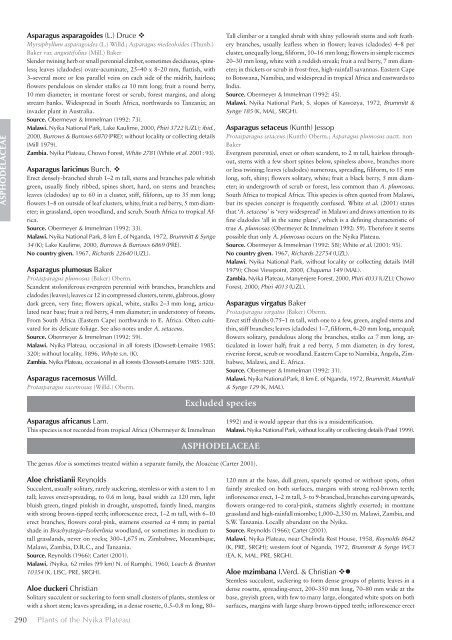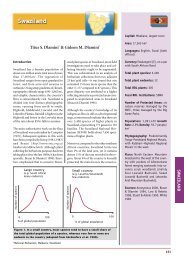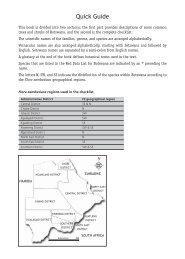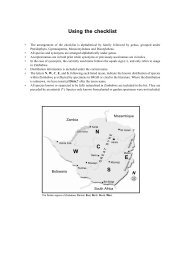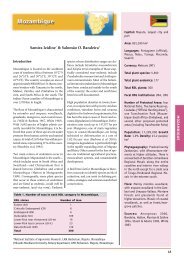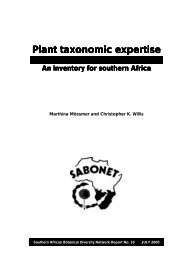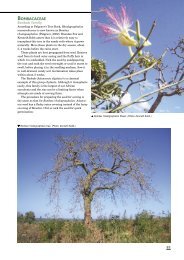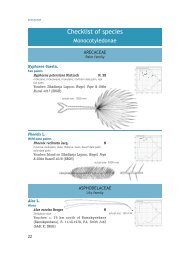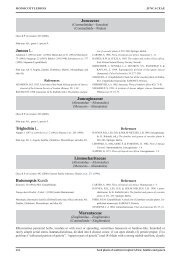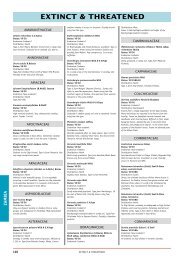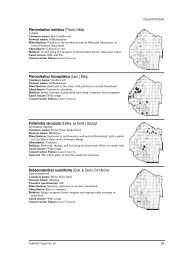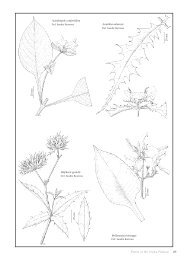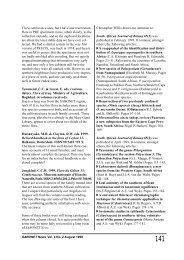266-299 - SABONET
266-299 - SABONET
266-299 - SABONET
Create successful ePaper yourself
Turn your PDF publications into a flip-book with our unique Google optimized e-Paper software.
ASPHODELACEAE<br />
Asparagus asparagoides (L.) Druce <br />
Myrsiphyllum asparagoides (L.) Willd.; Asparagus medeoloides (Thunb.)<br />
Baker var. angustifolius (Mill.) Baker<br />
Slender twining herb or small perennial climber, sometimes deciduous, spineless;<br />
leaves (cladodes) ovate-acuminate, 25–40 x 8–20 mm, flattish, with<br />
3–several more or less parallel veins on each side of the midrib, hairless;<br />
flowers pendulous on slender stalks ca 10 mm long; fruit a round berry,<br />
10 mm diameter; in montane forest or scrub, forest margins, and along<br />
stream banks. Widespread in South Africa, northwards to Tanzania; an<br />
invader plant in Australia.<br />
Source. Obermeyer & Immelman (1992: 73).<br />
Malawi. Nyika National Park, Lake Kaulime, 2000, Phiri 3722 (UZL); ibid.,<br />
2000, Burrows & Burrows 6870 (PRE); without locality or collecting details<br />
(Mill 1979).<br />
Zambia. Nyika Plateau, Chowo Forest, White 2781 (White et al. 2001: 93).<br />
Asparagus laricinus Burch. <br />
Erect densely-branched shrub 1–2 m tall, stems and branches pale whitish<br />
green, usually finely ribbed, spines short, hard, on stems and branches;<br />
leaves (cladodes) up to 60 in a cluster, stiff, filiform, up to 35 mm long;<br />
flowers 1–8 on outside of leaf clusters, white; fruit a red berry, 5 mm diameter;<br />
in grassland, open woodland, and scrub. South Africa to tropical Africa.<br />
Source. Obermeyer & Immelman (1992: 33).<br />
Malawi. Nyika National Park, 8 km E. of Nganda, 1972, Brummitt & Synge<br />
34 (K); Lake Kaulime, 2000, Burrows & Burrows 6869 (PRE).<br />
No country given. 1967, Richards 22640 (UZL).<br />
Asparagus plumosus Baker<br />
Protasparagus plumosus (Baker) Oberm.<br />
Scandent stoloniferous evergreen perennial with branches, branchlets and<br />
cladodes (leaves); leaves ca 12 in compressed clusters, terete, glabrous, glossy<br />
dark green, very fine; flowers apical, white, stalks 2–3 mm long, articulated<br />
near base; fruit a red berry, 4 mm diameter; in understorey of forests.<br />
From South Africa (Eastern Cape) northwards to E. Africa. Often cultivated<br />
for its delicate foliage. See also notes under A. setaceus.<br />
Source. Obermeyer & Immelman (1992: 59).<br />
Malawi. Nyika Plateau, occasional in all forests (Dowsett-Lemaire 1985:<br />
320); without locality, 1896, Whyte s.n. (K).<br />
Zambia. Nyika Plateau, occasional in all forests (Dowsett-Lemaire 1985: 320).<br />
Asparagus racemosus Willd.<br />
Protasparagus racemosus (Willd.) Oberm.<br />
Asparagus africanus Lam.<br />
This species is not recorded from tropical Africa (Obermeyer & Immelman<br />
290 Plants of the Nyika Plateau<br />
Excluded species<br />
ASPHODELACEAE<br />
The genus Aloe is sometimes treated within a separate family, the Aloaceae (Carter 2001).<br />
Aloe christianii Reynolds<br />
Succulent, usually solitary, rarely suckering, stemless or with a stem to 1 m<br />
tall; leaves erect-spreading, to 0.6 m long, basal width ca 120 mm, light<br />
bluish green, tinged pinkish in drought, unspotted, faintly lined, margins<br />
with strong brown-tipped teeth; inflorescence erect, 1–2 m tall, with 6–10<br />
erect branches, flowers coral-pink, stamens exserted ca 4 mm; in partial<br />
shade in Brachystegia–Isoberlinia woodland, or sometimes in medium to<br />
tall grasslands, never on rocks; 300–1,675 m. Zimbabwe, Mozambique,<br />
Malawi, Zambia, D.R.C., and Tanzania.<br />
Source. Reynolds (1966); Carter (2001).<br />
Malawi. ?Nyika, 62 miles (99 km) N. of Rumphi, 1960, Leach & Brunton<br />
10354 (K, LISC, PRE, SRGH).<br />
Aloe duckeri Christian<br />
Solitary succulent or suckering to form small clusters of plants, stemless or<br />
with a short stem; leaves spreading, in a dense rosette, 0.5–0.8 m long, 80–<br />
Tall climber or a tangled shrub with shiny yellowish stems and soft feathery<br />
branches, usually leafless when in flower; leaves (cladodes) 4–8 per<br />
cluster, unequally long, filiform, 10–16 mm long; flowers in simple racemes<br />
20–30 mm long, white with a reddish streak; fruit a red berry, 7 mm diameter;<br />
in thickets or scrub in frost-free, high-rainfall savannas. Eastern Cape<br />
to Botswana, Namibia, and widespread in tropical Africa and eastwards to<br />
India.<br />
Source. Obermeyer & Immelman (1992: 45).<br />
Malawi. Nyika National Park, S. slopes of Kawozya, 1972, Brummitt &<br />
Synge 185 (K, MAL, SRGH).<br />
Asparagus setaceus (Kunth) Jessop<br />
Protasparagus setaceus (Kunth) Oberm.; Asparagus plumosus auctt. non<br />
Baker<br />
Evergreen perennial, erect or often scandent, to 2 m tall, hairless throughout,<br />
stems with a few short spines below, spineless above, branches more<br />
or less twining; leaves (cladodes) numerous, spreading, filiform, to 15 mm<br />
long, soft, shiny; flowers solitary, white; fruit a black berry, 5 mm diameter;<br />
in undergrowth of scrub or forest, less common than A. plumosus.<br />
South Africa to tropical Africa. This species is often quoted from Malawi,<br />
but its species concept is frequently confused. White et al. (2001) states<br />
that ‘A. setaceus’ is ‘very widespread’ in Malawi and draws attention to its<br />
fine cladodes ‘all in the same plane’, which is a defining characteristic of<br />
true A. plumosus (Obermeyer & Immelman 1992: 59). Therefore it seems<br />
possible that only A. plumosus occurs on the Nyika Plateau.<br />
Source. Obermeyer & Immelman (1992: 58); White et al. (2001: 95).<br />
No country given. 1967, Richards 22754 (UZL).<br />
Malawi. Nyika National Park, without locality or collecting details (Mill<br />
1979); Chosi Viewpoint, 2000, Chapama 149 (MAL).<br />
Zambia. Nyika Plateau, Manyenjere Forest, 2000, Phiri 4033 (UZL); Chowo<br />
Forest, 2000, Phiri 4013 (UZL).<br />
Asparagus virgatus Baker<br />
Protasparagus virgatus (Baker) Oberm.<br />
Erect stiff shrubs 0.75–1 m tall, with one to a few, green, angled stems and<br />
thin, stiff branches; leaves (cladodes) 1–7, filiform, 4–20 mm long, unequal;<br />
flowers solitary, pendulous along the branches, stalks ca 7 mm long, articulated<br />
in lower half; fruit a red berry, 5 mm diameter; in dry forest,<br />
riverine forest, scrub or woodland. Eastern Cape to Namibia, Angola, Zimbabwe,<br />
Malawi, and E. Africa.<br />
Source. Obermeyer & Immelman (1992: 31).<br />
Malawi. Nyika National Park, 8 km E. of Nganda, 1972, Brummitt, Munthali<br />
& Synge 129 (K, MAL).<br />
1992) and it would appear that this is a misidentification.<br />
Malawi. Nyika National Park, without locality or collecting details (Patel 1999).<br />
120 mm at the base, dull green, sparsely spotted or without spots, often<br />
faintly streaked on both surfaces, margins with strong red-brown teeth;<br />
inflorescence erect, 1–2 m tall, 3- to 9-branched, branches curving upwards,<br />
flowers orange-red to coral-pink, stamens slightly exserted; in montane<br />
grassland and high-rainfall miombo; 1,000–2,350 m. Malawi, Zambia, and<br />
S.W. Tanzania. Locally abundant on the Nyika.<br />
Source. Reynolds (1966); Carter (2001).<br />
Malawi. Nyika Plateau, near Chelinda Rest House, 1958, Reynolds 8642<br />
(K, PRE, SRGH); western foot of Nganda, 1972, Brummitt & Synge WC3<br />
(EA, K, MAL, PRE, SRGH).<br />
Aloe mzimbana I.Verd. & Christian <br />
Stemless succulent, suckering to form dense groups of plants; leaves in a<br />
dense rosette, spreading-erect, 200–350 mm long, 70–80 mm wide at the<br />
base, greyish green, with few to many large, elongated white spots on both<br />
surfaces, margins with large sharp brown-tipped teeth; inflorescence erect


